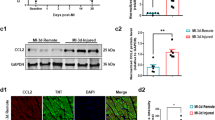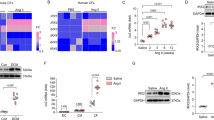Abstract
Background
CCN family of proteins has been implicated in various processes in cardiovascular physiology and pathology, including angiogenesis, regeneration and fibrosis. In this study we assessed long term changes of CCN1 and CCN2 gene products abundance in the failing ventricular myocardium.
Methods
Male, 12–14-weeks-old C57BL6/J and C57BL6/J IL−6−/− mice were used. To assess short term changes, a transient reversible ischemia model was utilized. Heart failure was caused by ligation of anterior descending coronary artery. The presence of systolic dysfunction was confirmed by echocardiography and left ventricular ANP RNA expression. Molecular analysis was performed on left ventricular samples from animals sacrificed 12–14 weeks after infarction. Western blotting and QT-PCR were used to investigate abundance of CCN proteins and RNAs, respectively.
Results
Short ischemia resulted in marked increase of CCN1 transcript. However, three months after myocardial infarction (MI), remote myocardium showed a markedly increased expression of CCN1 protein, but not RNA. In the case of CCN2, the RNA was distinctly up-regulated, whereas the protein presented only modest, non-significant increase in failing myocardium. Expression of CCN2 RNA closely correlated with expression of ANP. Long-term telmisartan administration after infarction decreased the expression of CCN1 protein. Interleukin 6 (IL-6) deficiency caused increased CCN2 protein abundance in control animals, but the difference was absent after MI. Infarction did not increase CCN1 protein in the hearts of IL-6 deficient mice.
Conclusion
CCN genes are activated in heart failure. Their regulation is multidimensional both transcriptional and posttranscriptional. The involved pathways include angiotensin II and IL-6.
Similar content being viewed by others
References
Chen CC, Lau LF. Functions and mechanisms of action of CCN matricellular proteins. Int J Biochem Cell Biol 2009;41(4):771–83.
Hilfiker A, Hilfiker-Kleiner D, Fuchs M, Kaminski K, Lichtenberg A, Rothkoetter H-J, et al. Expression of CYR61, an angiogenic immediate early gene, in arteriosclerosis and its regulation by angiotensin II. Circulation 2002; 106(2):254–60.
Bonda TA, Kamiński KA, Dziemidowicz M, Litvinovich S, Kożuch M, Hirnle T, et al. Atrial expression of the CCN1 and CCN2 proteins in chronic heart failure. Folia Histochem Cytobiol 2012;50(April (1)):99–103.
Hilfiker-Kleiner D, Kaminski K, Kaminska A, Fuchs M, Klein G, Podewski E, et al. Regulation of proangiogenic factor CCN1 in cardiac muscle: impact of ischemia, pressure overload, and neurohumoral activation. Circulation 2004; 109(18):2227–33.
Kaminski KA, Szepietowska B, Bonda T, Kozuch M, Mencel J, Małkowski A, et al. CCN2 protein is an announcing marker for cardiac remodeling following STZ-induced moderate hyperglycemia in mice. Pharmacol Rep 2009;61(3): 496–503.
Gabrielsen A, Lawler PR, Yongzhong W, Steinbrüchel D, Blagoja D, Paulsson-Berne G, et al. Gene expression signals involved in ischemic injury, extracellular matrix composition and fibrosis defined by global mRNA profiling of the human left ventricular myocardium. J Mol Cell Cardiol 2007 Apr;42(4): 870–83.
Bonda TA, Taranta A, Kaminski KA, Dziemidowicz M, Litvinovich S, Kozuch M, et al. CCN1 expression in interleukin-6 deficient mouse kidney in experimental model of heart failure. Folia Histochem Cytobiol 2013;51(1):84–91.
Kamiński KA, Kozuch M, Bonda TA, Stepaniuk MM, Waszkiewicz E, Chyczewski L, et al. Effect of interleukin 6 deficiency on the expression of Bcl-2 and Bax in the murine heart. Pharmacol Rep 2009;61(3):504–13.
Dawn B, Xuan YT, Guo Y, Rezazadeh A, Stein AB, Hunt G, et al. IL-6 plays an obligatory role in late preconditioning via JAK-STAT signaling and upregulation of iNOS and COX-2. Cardiovasc Res 2004;64(1):61–71.
Holbourn KP, Acharya KR, Perbal B. The CCN family of proteins: structure-function relationships. Trends Biochem Sci 2008;33(10):461–73.
Lin MT, Kuo IH, Chang CC, Chu CY, Chen HY, Lin BR, et al. Involvement of hypoxia-inducing factor-1alpha-dependent plasminogen activator inhibitor-1 up-regulation in Cyr61/CCN1-induced gastric cancer cell invasion. J Biol Chem 2008;283(23):15807–15.
Kunz M, Moeller S, Koczan D, Lorenz P, Wenger RH, Glocker MO, et al. Mechanisms of hypoxic gene regulation of angiogenesis factor Cyr61 in melanoma cells. J Biol Chem 2003;278(46):45651–60.
Liu L, Zhu J, Glass PS, Brink PR, Rampil IJ, Rebecchi MJ. Age-associated changes in cardiac gene expression after preconditioning. Anesthesiology 2009; 111(5):1052–64.
Leng E, Malcolm T, Tai G, Estable M, Sadowski I.Organization and expression of the Cyr61 gene in normal human fibroblasts. J Biomed Sci 2002;9(1):59–67.
Johannes G, Carter MS, Eisen MB, Brown PO, Sarnow P. Identification of eukaryotic mRNAs that are translated at reduced cap binding complex eIF4F concentrations using a cDNA microarray. Proc Natl Acad Sci USA 1999; 96(23):13118–23.
Sukumaran V, Watanabe K, Veeraveedu PT, Thandavarayan RA, Gurusamy N, Ma M, et al. Telmisartan, an angiotensin-II receptor blocker ameliorates cardiac remodeling in rats with dilated cardiomyopathy. Hypertens Res 2010;33(7):695–702.
Perbal B. Alternative splicing of CCN mRNAs ... it has been upon us. J Cell Commun Signal 2009;3(2):153–7.
Gądek-Michalska A, Tadeusz J, Rachwalska P, Bugajski J. Cytokines, prosta-glandins and nitric oxide in the regulation of stress-response systems. Pharmacol Rep 2013;65(6):1655–62.
Ridker PM, Lüscher TF. Anti-inflammatory therapies for cardiovascular disease. Eur Heart J 2014;35(27):1782–91.
Chłopicki S, Kurdziel M, Sternak M, Szafarz M, Szymura-Oleksiak J, Kamiński K, et al. Single bout of endurance exercise increases NNMT activity in the liver and MNA concentration in plasma; the role of IL-6. Pharmacol Rep 2012; 64(2):369–76.
Kok SH, Hou KL, Hong CY, Wang JS, Liang PC, Chang CC, et al. Simvastatin inhibits cytokine-stimulated Cyr61 expression in osteoblastic cells: a therapeutic benefit for arthritis. Arthritis Rheum 2011;63(4):1010–20.
Bai T, Chen CC, Lau LF. Matricellular protein CCN1 activates a proinflamma-tory genetic program in murine macrophages. J Immunol 2010;184(6): 3223–32.
Katsube K, Sakamoto K, Tamamura Y, Yamaguchi A. Role of CCN, a vertebrate specific gene family, in development. Dev Growth Differ 2009;51(1): 55–67.
Grote K, Salguero G, Ballmaier M, Dangers M, Drexler H, Schieffer B. The angiogenic factor CCN1 promotes adhesion and migration of circulating CD34+ progenitor cells: potential role in angiogenesis and endothelial regeneration. Blood 2007;110(3):877–85.
Mo FE, Muntean AG, Chen CC, Stolz DB, Watkins SC, Lau LF. CYR61 (CCN1) is essential for placental development and vascular integrity. Mol Cell Biol 2002;22(24):8709–20.
Author information
Authors and Affiliations
Corresponding author
Rights and permissions
About this article
Cite this article
Bonda, T.A., Kożuch, M., Litvinovich, S. et al. Transcriptional and post-transcriptional regulation of CCN genes in failing heart. Pharmacol. Rep 67, 204–208 (2015). https://doi.org/10.1016/j.pharep.2014.08.019
Received:
Revised:
Accepted:
Published:
Issue Date:
DOI: https://doi.org/10.1016/j.pharep.2014.08.019




